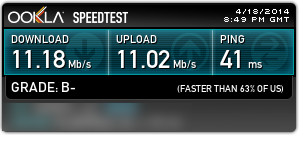 Mobile warriors, rejoice!
Mobile warriors, rejoice!
I could sum up this review with those three words, but that's hardly enough detail, no?
The NETGEAR PR2000 is a unique, specialized product but manages to be very easy to set up and use. Its footprint is incredibly small -- only about 3.3 inches square -- and can be powered either by plugging directly into the wall or via USB. This makes it ultra-convenient. Plus, it's actually three products in one:
- Range extender
- Wi-Fi Bridge for Ethernet devices
- Mobile Wi-Fi router and hotspot
The PR2000 also allows for USB file sharing over the Wi-Fi network! So, it's becoming clear that the PR2000 solves a variety of problems encountered in the home and while travelling. Let's dive deeper into what it can do.
NETGEAR PR2000 (Trek) As a Range Extender
Range extenders are purpose built devices that "hook on" to an existing Wi-Fi connection as provided by a wireless router and amplify that signal to extend coverage beyond the range of that router. For example, let's say a dead zone in coverage exists on your porch. A range extender could be placed halfway between the porch area and the location of the main router to bring a useable connection while sipping your beer and grilling brats.
The Trek is set up to function as a range extender, and in fact can be specifically optimized to do so. Following the incredibly simple setup instructions -- which involve not much more than turning on the Trek -- selecting a wireless network to connect to, and checking a box to "Extend my current wireless router's range," the Trek will create its own hotspot for wireless devices to connect to in the area it's designated to cover. It's that easy!
NETGEAR PR2000 (Trek) As a Wi-Fi to Ethernet Bridge
In some cases users will want to provide Internet coverage to a device that does not support a Wi-Fi connection, such as an XBOX 360 (which does not natively provide wireless) or other set-top box. This can also be useful in a hotel room that only provides one Ethernet connection, or if that connection is inconvenient for the device to reach.
Using almost exactly the same setup as range extender mode, users can connect an Ethernet device to the LAN port of the Trek, extending a wired Internet connection where one did not previously exist. Neato!
NETGEAR PR2000 (Trek) As a Travel Wi-Fi Router
I feel this is the coolest and most useful application for the Trek. It's basically a pocket-sized wireless router; the explanation couldn't get any more straightforward. The same setup steps as before are followed, except that the user won't check the "extend" option, and a public hotspot is used for the connection.
The benefits of this are many:
- Users are protected against a variety of security vulnerabilities of public hotspots due to the built-in firewall of the Trek.
- It provides an easy way to get around crappy hotel Wi-Fi. If you've ever tried to actually get a decent connection on hotel Wi-Fi, you know what I'm getting at. Connect the Trek to the Ethernet connection instead and make your own Wi-Fi hotspot -- it's not only safer, but faster, and you can connect all your wireless devices easily.
- Have a mobile 4G hotspot, or a mobile phone that supports this? Instead of giving out your private password, simply connect your Trek to your mobile hotspot, and allow your friends or colleagues to connect to it instead.
To boot, the PR2000 sports a USB connection that can be used to share files via USB to those who are connected, or even a USB printer. A nice bonus is that the USB port can also be used, when plugged into an outlet, to charge a cellphone or mobile device.
It's also prudent to mention that the PR2000 can function as an in-home router, too. It probably isn't robust enough for power users to utilize as their main connection, but it would do the job nicely for small apartments, college dorms, or those with simple routing needs without a lot of devices to connect.
So, how good is the PR2000?
All these features are indeed pretty sweet, but how does it work? In short -- great.
To start off, the Trek was a snap to get running. It lacks the extended features and customizability of beefier routers, which is a trade off, as this simplifies setup. I literally had it running within a few minutes, which is cliche but true. It did take a short whilefor it to establish a connection with my R7000, but afterwards, it functioned all day as my main connection without a hitch.
The only negative point I found with the PR2000 is that, when used as a travel router, it did decrease throughput. While connected to the PR2000 (which was using the Wi-Fi connection from my R7000) I was able to achieve speeds of about 11 Mbps.

Connected directly to the router, I consistently achieved around 15 Mbps.

I struggle with even calling this a negative, as it's pretty much a given that a range extender or a travel router such as this would suffer some speed loss, but it's worth being aware of. On even a halfway decent connection, it won't ever be an issue for most users.
Conclusions
Based on my experience, the PR2000 is an all-around win, and a must have for those who travel. Not only is it a breeze to get working, it's stable and consistent and can function as three different products, depending on the need. Add that with some added "bonuses" like the USB connection for file sharing, printing, and charging mobile devices, a small form factor, and a crazy attractive price ($59.99 retail, $34.99 on Amazon right now!) I can't recommend it enough. I know it's earned a permanent place in my laptop bag.




